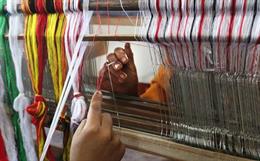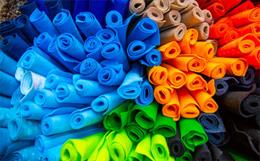The world of textiles in medical technology goes far deeper than bandages and masks. Learn about the future of fibre and how it intertwines with healing and wellness.
Medicine is an ever-evolving field, and the materials that health care workers use without thought today were once revolutionary. Textiles are an integral part of medicine, and as humanity creates innovations in textiles, the world of medicine is often the first to reap the rewards of these developments.
In modern times, it is still common to hear the phrase “medical textiles” and think of bandaging above all else. For centuries, however, innovations in textiles have gone hand in hand with innovations in medicine, and as the twenty-first century moves forward, humanity has seen countless advancements in both fields. Bandages are only the beginning: filters, sensors and even items as intricate as artificial heart valves exist today thanks to textiles.
The Evolution of Textiles in Medicine
For as long as medicine has existed, humans have used textiles to practise it. Some of the earliest evidence of textiles as bandages dates back at least five thousand years. The ancient Egyptians didn’t only use bandages to wrap mummies: they used linen to hold honey on open wounds. The honey would act as both an adhesive and an antiseptic. In fact, ancient Egyptian embalming methods directly influenced their use of cloth bandages on living patients. A clay tablet from 2200 BCE, meanwhile, is the earliest known medical manuscript. The tablet describes the “three healing gestures” of washing the wound, creating the dressings and wrapping the injured area.1
As the modern germ theory of disease began to take hold in the nineteenth and twentieth centuries and sterility became the new standard, medical textiles began to adapt to this new standard of cleanliness. In 1885, a German physician named Ernst von Bergmann was the first person to utilise steam to sterilise the surgical dressing he used. Since then, medical textiles have had to stand up to gas and extreme temperatures to ensure the death of any microorganisms within their fibres.
Wound dressings are far from the only utility of textiles in medicine, however. In ancient times, sutures were made from hemp, cotton or animal tendon. Nowadays, they are commonly made from silk or nylon. Likewise, medical textiles can be implanted in a human body in a vascular or heart valve graft or utilised outside of the body in cardiac and pulmonary surgeries.
In short, textiles have been an integral part of medicine for thousands of years, and the relationship between the two is close-knit. In the twenty-first century, humanity is working at a previously unimaginable scale, and innovations in materials and nanotechnology have enabled medicine to evolve at an amazing rate.
How Materials Science Has Advanced the World of Medical Technology
Without new materials, innovation in medicine is doomed to stall. Humanity has gone far beyond soaking cotton bandages in oil, and in the twenty-first century, scientists have delved into the microscopic realm to create new materials “from the ground up”. Some of these textiles have antimicrobial qualities, while others are created for durability, elasticity or sterilisation.
Since physicist Richard Feynman introduced the world to the concept of nanotechnology in 1959, the field of nanomaterials has shown great promise in medical applications. The small size and large surface area of these nanoparticles can increase the bioavailability of transdermal drugs, ensuring a sustained release. For many years, scientists have used nanotechnology to impregnate fabric with zinc oxide particles as well. Not only does this improve the resultant fabric’s antibacterial properties, but zinc oxide is also one of the most effective ways to prevent exposure to ultraviolet radiation.
The greatest advancements at the intersection of medical technology and textiles tend to surround antimicrobial fabric. Most commonly, this means inculcating fibres with nanoparticles of copper or silver. However, this is far from the only materials science development that has graced the world of medical textiles. The innovations that are leading to wearable sensors and sensory textiles come from nanotechnology as well.
Advancements in the materials that become textiles can also mean a lot to the medical community. Dissolving sutures and other biodegradable fibres, for instance, have been a staple of medicine since they were introduced nearly a century ago. Vascular grafts, tissue scaffolds and other delicate procedures rely on these textiles being sturdy for a set length of time and then dissolving as the patient’s body heals. New materials such as alginates and chitin may add new procedures to the list of possibilities.
The synthetic materials that are currently used inside human bodies are often not ideal for the task. Because many new synthetics tend to be closely related to old ones, the innovations that are changing some industries have yet to reach the medical world. However, scientists have begun to work with bioengineered materials such as polyanhydride to get around this.
Materials scientists are also using inorganic compounds called MXenes to create even smarter textiles. These compounds were first reported in 2012, and they are incredibly promising in this regard. Earlier in 2023, researchers at Drexel University in the United States designed a rechargeable supercapacitor patch that can theoretically power all manner of wearable technology. The researchers present the patch as an energy storage solution for health care technology such as continuous glucose monitors which currently need to be replaced regularly as their batteries drain.
Post-Pandemic Global Innovations in Medical Technology
Surgical masks, respirators and gowns are one of the primary symbols of the 2020s, and they are some of history’s most visible medical textiles. However, the COVID-19 pandemic has led to developments that go far beyond these symbols.
One of the most exciting recent developments in this regard is the use of molecular engineering to create cotton fibres that are antibacterial and antiviral. While people have been imbuing cotton textiles with antimicrobial liquids for decades, the resultant fabrics tend not to have long-term stability. A December 2022 paper in the journal Nature Nanotechnology takes a different approach. Instead of soaking completed fabric in a liquid additive, the researchers impregnated the cotton’s cellulose matrix with copper to form a copper ion-textile. This material is inexpensive and easy to create, ecologically friendly and highly promising for medical and household uses alike. It has shown high performance against a variety of viruses and bacteria, including influenza, E. coli, and salmonella.
Another innovation in materials science is the development of “smart textiles”. Bio-indicators such as heart rate, blood oxygen levels and blood pressure are fundamental to a medical professional’s understanding of a patient’s situation. However, tracking these over long periods is not always practical: the sensors are often bulky and uncomfortable, and their adhesives can frequently cause skin irritation. These sensors are also incompatible with many research applications such as sports medicine, where the research subject needs to be mobile. Functional textiles are beginning to come to the rescue here. They use textile-based sensors for a wide variety of purposes: not only are electroconductive yarns coming to the forefront, but other biosensors for things like a patient’s breathing rate, as well.
Biocompatible fabric is another avenue in which medical textiles have been improved using modern technology. With new synthetic materials becoming available, these textiles can be used in implants, blood filtration, medical devices and they can even be used to help stimulate cell growth. Especially for internal applications, these textiles should not trigger blood clotting, allergic reactions, infections or other adverse effects. Although scientists have been working with biocompatible materials for decades, new materials such as Sefar’s MEDIFAB provide unparalleled stability and homogeneity in this regard.
Meanwhile, researchers at the University of Nottingham developed a new class of polymer in 2022. While the polymer in itself is not a medical textile, they have impregnated wound dressings with these microparticles, and the resultant material is showing a great deal of promise in the treatment of chronic wounds in people with diabetes. This may soon be able to help prevent diabetic patients from needing limb amputations.
Similar advancements in nanotechnology have combined with new developments in textiles to facilitate healing and tissue growth. At the November 2022 Compamed trade fair in Germany, Freudenberg Performance Materials demonstrated a new series of nonwoven textiles in the brand’s Eco- Check label. These materials are made of polylactic acid and bio-based fibres from natural sources. As nonwovens, they can easily be optimised for a variety of utilities, from fluid absorption to long-term wound care. Even better, these textiles are all industrially compostable.
The US-based biotech firm Kraig Biocraft Laboratories recently began to ship samples of its newest genetically engineered spider silk fibres for medical use. The material is lightweight, biocompatible and completely biodegradable. Even better, it is scalable: one of the main reasons that the medical field does not frequently use spider silk is because it is difficult to produce in bulk. By implanting domesticated silkworms with spider genes, Kraig has been able to overcome this obstacle. The resultant materials are lighter, stronger and far more flexible than steel, with amazing tensile strength, so manufacturers of body armour are also very interested in these textiles.
Another new development in smart textiles is the creation of textiles that help the wearers regulate their temperature. This personalised thermoregulation system was first proposed in 2021, and it shows particular promise in medicine. In particular, babies who were born prematurely cannot thermoregulate on their own, often for the first several months of their lives. The current solution to this problem is to place the infant in an incubator. These incubators take a lot of space and energy, making them ill-suited to use in areas where electricity is rare. Imagine smart bedding that can automatically adapt its temperature to the infant’s temperature needs, using integrated sensors to calibrate for both the baby’s temperature and the room’s. This would be far more efficient and would allow doctors to reallocate their limited resources across more patients.
Other recent innovations in smart medical textiles are on the verge of revolutionising the world of healthcare. Bandages, for instance, can be used not only for wound cleansing and care, but as a diagnostic tool. In 2020, a Chinese research team developed fabric bandages that change colour based on a wound’s pH level. Many bacteria, including some of the most difficult ones to treat, produce an acidic environment as they grow, so this colour change is a highly effective early indicator that a patient needs quick treatment. Further, these same textiles can be imbued with microscopic ampoules that contain ampicillin, a powerful antibiotic. These ampoules dissolve in acidic environments, so the drug is only released if truly needed. Other smart bandage prototypes can monitor chronic wounds, deliver medications on a set schedule, and change colour if the patient develops a fever.
Not all textiles are made of fabric, and one of the most exciting potential applications in medical textiles displays this principle well. Human bodies tend to reject most foreign materials that are implanted into them. While broken bones can have titanium pins, and similar principles, this has rendered more delicate long-term repairs difficult. A researcher at the French National Institute of Health and Medical Research (INSERM) named Nicolas L’Heureux is changing that. His team has pioneered the use of human cells to create medical fabrics. In the future, doctors may be able to fabricate bone and tissue grafts from a patient’s own DNA with this fabric. The fibres can even be braided or woven, maximising their utility.
Belly bands, meanwhile, made their debut nearly a decade ago, and advancements in electrically conductive thread, knitting machines and smartphone technology may make them commercially viable in the near future. These fabric bands are worn like undergarments, and they use passive radio frequency identification technology to monitor key biomarkers such as uterine contractions and foetal heart rate. For people facing a high-risk pregnancy, this may provide peace of mind and alert them to problems before they become severe.
Finally, 3D printed textiles are showing a great deal of promise in medicine. Textiles can be printed from shape memory polymers (SMPs) or shape memory alloys to create flexible, cost-effective treatments for anything from leg ulcers to broken bones. Because these materials change their shape based on ambient conditions, they are easier to place than traditional fibreglass casts are, and they are far more lightweight than their counterparts as well.
The Importance of International Collaboration in Medical Textiles
Health is one of the greatest equalising factors that humans share. Regardless of origin, class, gender or other factors, everybody on Earth will need medical care at some point. Access to this health care is one of the key factors that influences a person’s quality of life. In our increasingly connected world, international collaboration is critical to distributing this technology equitably.
Medical technology has a lot to learn from fast fashion in this regard. In particular, it can take lessons regarding fast fashion’s logistics and sourcing abilities. The planet’s supply of the fibres that make up medical textiles is limited, and the competition between the two industries can be cutthroat. Future developments in the world of textiles should have both fashion and function in mind.
This goes beyond just the basic function of textiles. While the logistical “pyramid” of the fast fashion industry points toward high-income areas like Europe and North America, with lower-income countries doing the bulk of the production. However, for medical textiles, the pyramid needs to be inverted. These materials need to be used around the world and affordable especially where they need to be used more.
To complicate matters further, medical textiles have stringent requirements such as sterility and quality control, where fast fashion deals with fewer of these barriers. For millennia, people have been able to make their own clothing. They cannot, however, create and sterilise their own surgical dressings, let alone more intricate materials. International collaboration is thus a key component of public health and safety.
Many companies have switched to a horizontal supply chain for exactly this reason: collaboration across international and cultural borders means that materials scientists can innovate more at a lower cost, and that they have multiple approaches to solving the problems that may arise.
A horizontal supply chain can make medical textiles’ ownership, inventorship and intellectual property difficult to navigate, however. Patent and trademark laws work differently in every country, and when a single textile manufacturer takes a monopoly on producing a specialised medical item, the interactions of these laws can lead to a lower quality of patient care as innovations are delayed. Meanwhile, regulatory agencies in each country have their own timelines for approving inventions for human use. Broadening the development process and the supply chain allows companies to bring their products to some markets even if agencies delay their approval in other areas.
How Medical Textiles Continue to Improve Public Health and Hygiene
By far the most readily visible impact of medical textiles on public health is respirators and masks. Masks are an inexpensive, effective way to drastically reduce the community transmission of diseases. They are one of the keys to preventing community spread of not only COVID-19, but influenza and other airborne diseases. In particular, a 2022 study by the United States Centers for Disease Control and Prevention showed that a properly fitting respirator reduced participants’ chance of a positive COVID-19 test by 83 per cent.2 Another study the same year showed similar results, with a 65 to 75 per cent risk reduction in mask wearers.3
Masks and respirators, bandages, gowns and bedding are far from the only way that people use textiles to prevent disease, however. As infection rates of hospital-acquired diseases like C. difficile and methicillin resistant Staphylococcus aureus continue to rise, medical professionals are on the lookout for drug-free ways to prevent this spread, and textiles are one of the first-line solutions to the problem.
The more durable that these antimicrobial textiles become, the lower the transmission rates of these diseases will be. Not only that, but the rates of post-surgical infections and other complications will be drastically reduced. Finally, the less expensive and more accessible these textiles become, the fewer harmful chemicals will be needed to sanitise hospital settings. Reusable antimicrobial textiles have a similar positive impact. This is a net benefit for the environment as well. Simply treating the textiles with chemicals does not have a lasting impact, however, which is why it is so important to develop new materials that prevent microbial growth in the first place.
The Future of Medicine is Fibrous
Imagine a future where diabetic people can monitor their blood glucose by looking at a fabric bracelet or avoid dangerous foot ulcers using smart socks that track inflammation in their feet. Imagine shoes that can track a person’s heart rate, or liners of sports helmets that send an alert when a player’s head has sustained excessive force. These technologies are not quite ready for mass production, but all of them are well within the realm of possibility.
With the planet’s changing climate, it is also important for textile producers to minimise their impact on the environment. Many medical textiles can only be used once before they lose sterility and are discarded. Right now, most of these applications cannot use recycled materials for similar reasons: without the ability to track a material’s cleanliness, it can be difficult to maintain medical standards. As more biodegradable and environmentally friendly artificial fibres make their way to the market, manufacturers of medical textiles should evaluate their utility in a single-use environment.
Just as smart watches and wearable fitness trackers revolutionised the world of exercise, smart fibres and nanotechnology will bring major changes to textiles. The future has never been set in stone: humanity can influence it. What remains to be seen is what humanity chooses to do with the tools at hand. Firms should be mindful of these new fibres’ power and use them for the greatest public benefit.
- https://www.ncbi.nlm.nih.gov/pmc/articles/PMC3601883/
- https://www.cdc.gov/mmwr/volumes/71/wr/mm7106e1.htm
- https://www.pnas.org/doi/10.1073/pnas.2119266119







